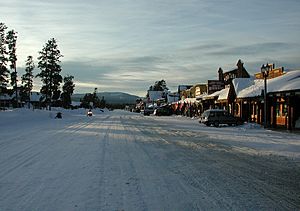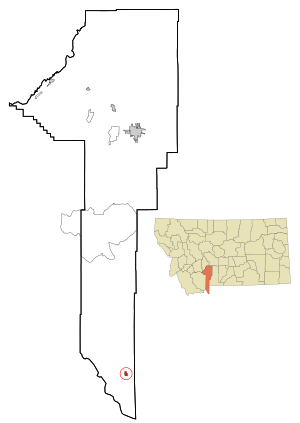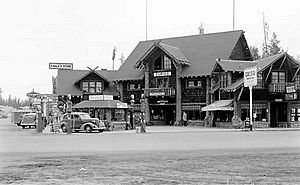West Yellowstone, Montana facts for kids
Quick facts for kids
West Yellowstone
|
||
|---|---|---|

Yellowstone Avenue in winter
|
||
|
||

Location of West Yellowstone within Gallatin County == Location ==
|
||
| Country | ||
| State | ||
| County | Gallatin == Area == | |
| Area | ||
| • Total | 0.91 sq mi (2.35 km2) | |
| • Land | 0.91 sq mi (2.35 km2) | |
| • Water | 0.00 sq mi (0.00 == Population == km2) | |
| Elevation | 6,667 ft (2,032 m) | |
| Population
(2020)
|
||
| • Total | 1,272 | |
| • Density | 1,400.88/sq mi (541.10/km2) | |
| Time zone | UTC-7 (Mountain) | |
| • Summer (DST) | UTC-6 (Mountain) | |
| ZIP Code |
59758
|
|
| Area code(s) | 406 | |
| FIPS code | 30-79525 | |
| GNIS ID | 2413469 | |
West Yellowstone is a town in Gallatin County, Montana, United States, adjacent to Yellowstone National Park. The population was 1,272 at the 2020 census. West Yellowstone is served by Yellowstone Airport. It is part of the Bozeman, MT Micropolitan Statistical Area.
West Yellowstone offers lodging, gift shops, and other services to travelers visiting nearby Yellowstone National Park.
Contents
History
Founded in June 1908 when the Oregon Short Line Railroad was completed, the town's name changed several times until West Yellowstone was settled upon in 1920. Train service to West Yellowstone ended in 1960. The town was incorporated in 1966.
Geography
According to the United States Census Bureau, the town has a total area of 0.80 square miles (2.07 km2), all land.
Climate
At 6,660 feet (2,030 m) above sea level and nearly halfway between the equator and the North Pole, West Yellowstone experiences a subarctic climate (Köppen climate classification Dfc), with cold — sometimes bitterly cold — winters and brief but generally warm summers. West Yellowstone is snow-covered from the beginning of November until the beginning of May. At the peak of the snowpack, which typically occurs in early March, there is 3.5 – 4 feet of snow on the ground. In 2007–2008, West Yellowstone had snow on the ground from late October until mid May, with 4.5 feet of snow by late March. During the summer, the average low is 41 °F (5 °C), and the average high is 78 °F (26 °C). During the coldest month, January, the average low is 0 °F (−18 °C), and the average high is 24 °F (−4 °C).
West Yellowstone holds the all-time lowest recorded temperature for any residential community in the contiguous United States at −66 °F (−54 °C), although a lower temperature was once recorded at Rogers Pass, Montana, at −70 °F (−57 °C).
| Climate data for West Yellowstone, Montana 1991–2020 normals, 1924-2020 extremes: 6679ft (2036m) | |||||||||||||
|---|---|---|---|---|---|---|---|---|---|---|---|---|---|
| Month | Jan | Feb | Mar | Apr | May | Jun | Jul | Aug | Sep | Oct | Nov | Dec | Year |
| Record high °F (°C) | 47 (8) |
56 (13) |
61 (16) |
76 (24) |
88 (31) |
93 (34) |
99 (37) |
96 (36) |
91 (33) |
83 (28) |
64 (18) |
54 (12) |
99 (37) |
| Mean maximum °F (°C) | 38.1 (3.4) |
42.2 (5.7) |
53.8 (12.1) |
65.8 (18.8) |
74.9 (23.8) |
84.5 (29.2) |
88.6 (31.4) |
88.4 (31.3) |
83.3 (28.5) |
69.1 (20.6) |
53.6 (12.0) |
38.3 (3.5) |
89.6 (32.0) |
| Mean daily maximum °F (°C) | 26.8 (−2.9) |
31.2 (−0.4) |
39.7 (4.3) |
47.7 (8.7) |
59.2 (15.1) |
68.4 (20.2) |
79.7 (26.5) |
77.9 (25.5) |
67.6 (19.8) |
50.8 (10.4) |
35.9 (2.2) |
25.8 (−3.4) |
50.9 (10.5) |
| Daily mean °F (°C) | 13.5 (−10.3) |
16.4 (−8.7) |
24.4 (−4.2) |
34.2 (1.2) |
43.9 (6.6) |
51.2 (10.7) |
59.4 (15.2) |
57.0 (13.9) |
48.6 (9.2) |
36.1 (2.3) |
23.6 (−4.7) |
14.2 (−9.9) |
35.2 (1.8) |
| Mean daily minimum °F (°C) | 0.2 (−17.7) |
1.5 (−16.9) |
9.1 (−12.7) |
20.7 (−6.3) |
28.5 (−1.9) |
33.9 (1.1) |
39.2 (4.0) |
36.2 (2.3) |
29.6 (−1.3) |
21.4 (−5.9) |
11.4 (−11.4) |
2.7 (−16.3) |
19.5 (−6.9) |
| Mean minimum °F (°C) | −27.8 (−33.2) |
−28.0 (−33.3) |
−13.4 (−25.2) |
3.4 (−15.9) |
16.6 (−8.6) |
25.2 (−3.8) |
28.6 (−1.9) |
26.4 (−3.1) |
20.1 (−6.6) |
5.5 (−14.7) |
−13.8 (−25.4) |
−28.0 (−33.3) |
−34.5 (−36.9) |
| Record low °F (°C) | −60 (−51) |
−66 (−54) |
−43 (−42) |
−26 (−32) |
0 (−18) |
18 (−8) |
20 (−7) |
15 (−9) |
−9 (−23) |
−20 (−29) |
−38 (−39) |
−59 (−51) |
−66 (−54) |
| Average precipitation inches (mm) | 2.28 (58) |
2.06 (52) |
2.17 (55) |
2.31 (59) |
2.70 (69) |
2.49 (63) |
1.30 (33) |
1.39 (35) |
1.69 (43) |
1.92 (49) |
2.61 (66) |
3.05 (77) |
25.97 (659) |
| Average snowfall inches (cm) | 26.6 (68) |
23.2 (59) |
16.6 (42) |
11.2 (28) |
1.8 (4.6) |
0.2 (0.51) |
0.0 (0.0) |
0.0 (0.0) |
0.6 (1.5) |
3.9 (9.9) |
19.7 (50) |
31.3 (80) |
135.1 (343.51) |
| Source 1: NOAA | |||||||||||||
| Source 2: XMACIS2 (2008-2020 snowfall) | |||||||||||||
| Climate data for West Yellowstone | |||||||||||||
|---|---|---|---|---|---|---|---|---|---|---|---|---|---|
| Month | Jan | Feb | Mar | Apr | May | Jun | Jul | Aug | Sep | Oct | Nov | Dec | Year |
| Record high °F (°C) | 47 (8) |
56 (13) |
61 (16) |
76 (24) |
88 (31) |
93 (34) |
97 (36) |
96 (36) |
91 (33) |
83 (28) |
64 (18) |
54 (12) |
97 (36) |
| Mean daily maximum °F (°C) | 24.1 (−4.4) |
30.5 (−0.8) |
38.0 (3.3) |
47.6 (8.7) |
58.7 (14.8) |
68.5 (20.3) |
78.8 (26.0) |
77.2 (25.1) |
66.4 (19.1) |
52.3 (11.3) |
33.8 (1.0) |
24.1 (−4.4) |
50.3 (10.2) |
| Daily mean °F (°C) | 12 (−11) |
16.5 (−8.6) |
23.4 (−4.8) |
33.7 (0.9) |
43.7 (6.5) |
51.9 (11.1) |
59.2 (15.1) |
57.2 (14.0) |
47.9 (8.8) |
37.2 (2.9) |
22.1 (−5.5) |
12.6 (−10.8) |
34.8 (1.5) |
| Mean daily minimum °F (°C) | −0.2 (−17.9) |
2.5 (−16.4) |
8.7 (−12.9) |
19.7 (−6.8) |
28.7 (−1.8) |
35.3 (1.8) |
39.6 (4.2) |
37.2 (2.9) |
29.4 (−1.4) |
22.1 (−5.5) |
10.3 (−12.1) |
1.0 (−17.2) |
19.6 (−6.9) |
| Record low °F (°C) | −63 (−53) |
−66 (−54) |
−43 (−42) |
−26 (−32) |
−4 (−20) |
18 (−8) |
20 (−7) |
15 (−9) |
−9 (−23) |
−20 (−29) |
−38 (−39) |
−59 (−51) |
−66 (−54) |
| Average precipitation inches (mm) | 1.96 (50) |
1.77 (45) |
1.87 (47) |
1.51 (38) |
2.19 (56) |
2.21 (56) |
1.84 (47) |
1.36 (35) |
1.47 (37) |
1.30 (33) |
2.01 (51) |
2.30 (58) |
21.79 (553) |
| Average snowfall inches (cm) | 32.9 (84) |
26.6 (68) |
23.3 (59) |
20.7 (53) |
3.3 (8.4) |
0.6 (1.5) |
0.0 (0.0) |
0.1 (0.25) |
1.2 (3.0) |
7.3 (19) |
22.9 (58) |
31.4 (80) |
170.3 (434.15) |
| Average precipitation days (≥ 1.0 mm) | 7.6 | 5.8 | 4.2 | 4.0 | 5.5 | 4.6 | 5.6 | 4.5 | 4.9 | 5.3 | 4.4 | 4.7 | 61.1 |
| Source 1: Weatherbase and WRCC (snow only) | |||||||||||||
| Source 2: Infoclimat.fr (average days with precipitation) | |||||||||||||
Demographics
| Historical population | |||
|---|---|---|---|
| Census | Pop. | %± | |
| 1930 | 200 | — | |
| 1940 | 300 | 50.0% | |
| 1950 | 400 | 33.3% | |
| 1960 | 500 | 25.0% | |
| 1970 | 756 | 51.2% | |
| 1980 | 735 | −2.8% | |
| 1990 | 913 | 24.2% | |
| 2000 | 1,177 | 28.9% | |
| 2010 | 1,271 | 8.0% | |
| 2020 | 1,272 | 0.1% | |
| source: U.S. Decennial Census | |||
2010 census
As of the census of 2010, there were 1,271 people, 617 households, and 298 families residing in the town. The population density was 1,588.8 inhabitants per square mile (613.4/km2). There were 969 housing units at an average density of 1,211.3 per square mile (467.7/km2). The racial makeup of the town was 86.6% White, 0.4% African American, 1.1% Native American, 0.9% Asian, 7.5% from other races, and 3.5% from two or more races. Hispanic or Latino people of any race were 17.9% of the population.
There were 617 households, of which 23.7% had children under the age of 18 living with them, 34.7% were married couples living together, 8.4% had a female householder with no husband present, 5.2% had a male householder with no wife present, and 51.7% were non-families. 42.1% of all households were made up of individuals, and 5.8% had someone living alone who was 65 years of age or older. The average household size was 2.06, and the average family size was 2.86.
The median age in the town was 39.4 years. 20.9% of residents were under the age of 18; 6.5% were between the ages of 18 and 24; 30.1% were from 25 to 44; 34.2% were from 45 to 64; and 8.4% were 65 years of age or older. The gender makeup of the town was 53.1% male and 46.9% female.
Economy
Tourism
Because of its proximity to Yellowstone National Park, the town receives a large amount of tourism, especially from China. To cater to these tourists, the town has commercial signage in Mandarin as well as six Chinese restaurants. It is estimated to receive more than half its annual business from Chinese tourists.
Education
The CDP is in the West Yellowstone K-12 school district.
The town has one school, the West Yellowstone School, serving kindergarten through 12th grade. West Yellowstone High School is a class C school (fewer than 108 students) which helps determine athletic competitions. They are known as the Wolverines.
West Yellowstone Public Library serves the area.
Media
Three radio stations are licensed in West Yellowstone. KWYS (AM), broadcasting at 920 kHz and locally owned by Radio West, LLC, plays an oldies format. The FM station KEZQ plays soft adult contemporary music. KPWY is a religious radio station.
Infrastructure
Layout
The D Parkway road roughly separates the town into residential and commercial areas. South of D Parkway is mainly a business/commercial area, while northward is a residential area of homes and apartments. The area north of D Parkway is known to locals as the "Madison Addition".
Transportation
The West Yellowstone Airport, a mainly summer-operating airport, is to the north of town.
U.S. Route 20 and U.S. Route 191 pass through the town.
The Union Pacific Railroad historically operated the Butte Special (29/30), which linked with a coordinated train, the Yellowstone Special (35/36), which ran from Pocatello, Idaho to West Yellowstone. The two trains ran linked from Pocatello to Idaho Falls, where the latter train split off for West Yellowstone. Service ended in 1971.
See also
 In Spanish: West Yellowstone (Montana) para niños
In Spanish: West Yellowstone (Montana) para niños



